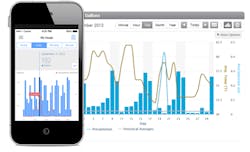By Kristie Anderson
Water utilities are increasingly moving past manual and touch read devices in favor of automatic meter reading (AMR), advanced metering infrastructure (AMI) and most recently, advanced metering analytics (AMA). This transition allows utilities to move from capturing a monthly or quarterly meter reading for billing purposes only to a more data-driven approach for improved decision-making.
This evolution began with walk-by/drive-by technology. Next came AMI technology, which provides hourly meter reading data that can be used proactively to help improve customer service, increase operational efficiency and provide end users with a better understanding of their water consumption.
Shifting to an AMI fixed network system can also yield a dramatic decrease in labor requirements specific to meter reading, reductions in costs related to meter reader injury, and an increase in the accuracy of meter reading recording. AMI systems also provide reductions in vehicle expense and fuel and, because more detailed information is now available to the utility staff, it often provides faster resolution of consumer calls and complaints about high bills.
While this technology evolution can provide great benefits, it has historically presented the utility with a new set of operational challenges, particularly related to the management of AMI communications infrastructure and analytics software and hardware. New technologies and business models, however, are making it far easier for water utilities to move to the next step: AMA.
Cloud-Based Software
Web-based software services -- more commonly called cloud computing or Software as a Service (SaaS) -- are being implemented globally by users in virtually all types of organizations, including manufacturing, government, services, retail, and water utilities. Cloud-based software services are bringing about rapid and diverse changes to how a water utility operates and how data is used. As new systems often require new technology resources to operate and support, utilities are finding cloud computing to be a viable alternative to investing in server-based meter data management systems (MDM).
Cloud-based or SaaS platforms share several major characteristics:
- Quick deployment
- No hardware to purchase
- Expert maintenance of the system so utilities can focus on their core competency
- Automatically implemented software updates
- Rapid elasticity or expansion capability as utility's needs change
- Subscription pricing that provides a pay-as-you-go option
These characteristics allow organizations to rapidly build IT resources through cloud-based software services, making it easier and less costly to adapt to changing utility requirements. The software applications are "hosted" by the solutions vendor in secure data centers, eliminating the need to install and maintain computer hardware and software at the utility. The utility simply has to provide a personal computer with a web browser to access the secure application software via the Internet. Having the software and data hosted offsite also leaves the utility's critical metering data less susceptible to natural disasters.
Historically, MDM systems often required software updates, and on occasion, the purchase and installation of a completely new version of software. With the increased functionality, more users within the utility may require access, often meaning additional licenses need to be purchased.
However, with cloud-based systems, software improvements are automatically updated by the solutions provider, requiring no effort on the part of the utility. In addition, the costs of these software improvements are included in the base subscription, meaning the utility can always be current with the most advanced software features without additional cost or effort.
Managed Solution Model
Metering suppliers have changed the paradigm for utility meter data management. Vendors now offer solutions that include a hands-off approach for the utility with regard to the data collection equipment, computer hardware and software applications. This new approach, referred to as a "managed solution," offers several benefits. The solutions vendor installs and maintains the data collection equipment, allowing the utility to relieve itself from the responsibility of installation and maintenance of everything except the meters and endpoints. With this approach, the software applications are "hosted" by the vendor.



